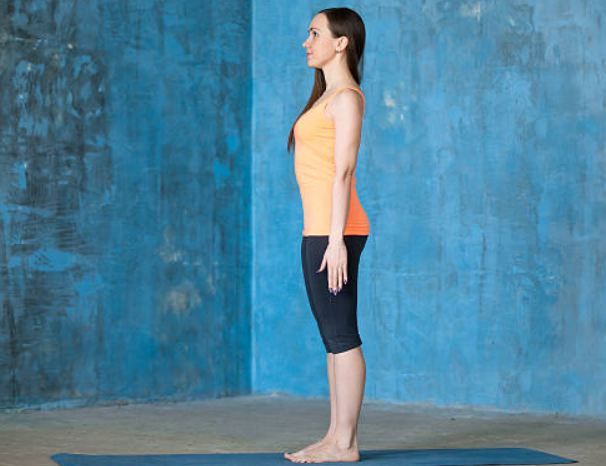Picture perfect posture is something we all strive for, but it doesn’t exist. The reality today is that most people’s posture falls far short of the ideal.
Poor posture is not only unflattering – it’s a little known health risk. Worse yet, the adverse effects of postural misalignment tend to slowly and silently accumulate over time until substantial pain and even disability occur.
Hunching over your desk to do computer work all day might not seem problematic, until the damage is done and you realize you can no longer straighten up!
By adulthood, most of us have already fallen into some poor postural habits (of which we may or may not be aware). You can check for some asymmetries in your body by looking in a mirror.
As early as age 8, there is evidence of widespread postural changes associated with dominant hand use.
A typical pattern for a right handed individual is as follows: right shoulder is lower than the left, Pelvis is deviated slightly toward the right, right hip is slightly higher, slight deviation of the spine to the left, and the left foot is more flat than the right.
Some deviations may be only detectable by the trained eye of a professional such as a chiropractor, doctor, or physical therapist, while others may be quite obvious.
Many of these postural deviations are thought to have developed because our society has become quite sedentary. (Can you say, “Couch Potato”?)
Even young children are exhibiting signs of postural stress related to sitting for long periods of time in school or while playing computer games. It used to be unheard of for a child to complain of neck and back pain not related to trauma.
A poor sitting position causes the entire back and pelvis to round out, as well as the head to come forward in a typical “slump” position.
The human body can be visualized as a kinetic chain. Our joints are linked together in such a way that the position of one joint affects the position of all the others.
In other words, segments of the body cannot move in isolation. They are all interconnected.
When our major joints are stacked appropriately, the human body can be maintained upright with little muscular effort, little stress to ligaments, and equally distributed compressive forces.
However, when posture is less than optimal, imbalances cause increased stress to the muscles, bones and connective tissue which affects the whole kinetic chain.
Our modern day society seems to encourage faulty alignment through the repetitive and restrictive nature of certain work related and everyday activities.
People who perform the same activity over and over again in the same position are overusing some muscles and underutilized others. Our bodies easily adapt to the demands we place on them.
The dominant hand or leg may become very strong, while the non-dominant side weakens, creating widespread strength and flexibility imbalances. Other muscles attempt to compensate until they too become compromised.
Potential sources of pain include muscle spasms and fatigue, ligament strain, pinching of nerves and blood vessels, joint inflammation and arthritis.
Individuals may seek medical attention as a result of the chronic pain, functional limitations and disability associated with postural dysfunction.
It is unfortunate that we only tend to recognize that we have a problem when our body’s are “screaming” at us.
Many postural issues go on ignored until the person experiences a traumatic event. The application of an acute stress, in addition to the chronic postural stress, can result in an injury that might otherwise have been very minor.
For example, the victim of a rear-end auto collision at only 5 miles per hour is diagnosed with whiplash due to poor alignment of his/her head to their neck which predisposed them to substantial injury.
Neck pain is highly correlated with poor posture and a forward head position (FHP) is often implicated. Ideally, the ear should be vertically in line with the shoulder.
The development of FHP is attributed to occupational or repetitive postures requiring prolonged sitting, forward leaning, habitual slouching and as a result poor vision.
The best example of this is working in front of your computer. The extensor muscles in the back of the neck must contract excessively to hold the head up and keep the eyes level.
The muscles in the front of the neck become overly stretched and weakened. FHP is frequently associated with Temporomandibular joint (TMJ) dysfunction, headaches, pinched nerves, and arthritis in the neck.
The position of the head also affects the orientation of the shoulder, arm and hand. FHP may also be implicated in carpal tunnel syndrome in the wrist.
Accompanying the adverse musculoskeletal changes is the loss of position sense. Over time, and individual with FHP loses the ability to position the head correctly on the cervical spine.
Eventually, poor posture progressively begins to feel like the body’s norm.
The good news is that correction of postural alignment has been shown to relieve pain and restore function, such as range of motion and strength.
Through specific exercises, the joints and muscles can be retrained. You can improve your posture through simple stretching exercises or reorganizing your workspace.
Taking frequent breaks can also help (at least 5 minutes every hour). Also, standing while you work when possible.
Finally, remember those words from your mother… stop slouching and sit up straight in your chair! Now is the time to do it.

